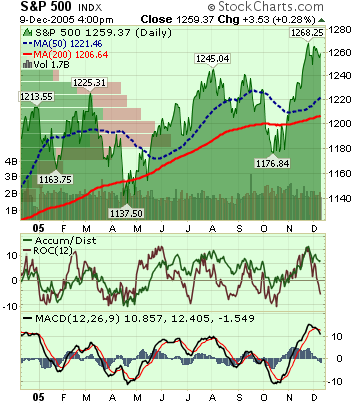
Click here for the Weekly Wrap by Briefing.com.
BOTTOM LINE: Overall, last week's market performance was just slightly negative considering recent gains, the rise in natural gas prices and disappointing comments from Toll Brothers(TOL) and Intel(INTC). The advance/decline line fell, sector performance was mixed and volume was above average on the week. Measures of investor anxiety were mostly lower. However, the AAII % Bulls fell again to 49.47%, slightly above average levels, which is a positive. The average 30-year mortgage rate rose for the first time in three weeks to 6.32%. This is 111 basis points above all-time lows set in June 2003. I continue to believe mortgage rates will head modestly lower over the intermediate-term as measures of inflation decelerate and economic growth slows to average rates. The benchmark 10-year T-note yield rose 1 basis point on the week as unit labor costs(the largest component of inflation) fell more-than-expected in 3Q, offsetting strong economic data.
Small-caps and cyclicals continued to outperform on increasing optimism over the unrelenting strength of the economy, falling only slightly on the week. Gold rose again on continuing international diversification into the precious metal. I still believe the rise in gold is not a result of increasing inflation fears as evidenced by the decline in unit labor costs this week. Unleaded Gas futures were basically unchanged and are 45% below September highs even as refinery utilization still remains below normal as a result of the hurricanes. Natural gas supplies decreased less-than-expected this week and are now 6.9% above the 5-year average for this time of year even as 29% of daily Gulf of Mexico production remains shut-in. I believe a significant top in natural gas occurred last week or will so shortly. Prices for many commodities are now being driven by fear and record capital inflows into commodity funds, rather than fundamentals. I still expect global energy demand destruction and a significant increase in supplies into 2006 to push energy prices substantially lower over the intermediate-term. The S&P 500 is still within striking distance of my mid-year prediction of a double-digit annual gain, but time is running out. The index is currently up 5.75% for the year.
US economic growth has now exceeded 3% for 10 straight quarters, the best streak since March 1986. Moreover, corporate profit growth has reached double-digit rates for 14 quarters in a row, the best run since at least 1936. I want to reiterated the point that quite possibly there has never before in US history been a greater disconnect between economic perception and reality. This disconnect is fueled by the record number of market participants that perceive that they benefit, both politically and financially, from the demise of the US economy. This, in turn, leads to an overwhelmingly negative spin on almost any positive event. Irrational pessimism is pervasive as a recent poll by American Research Group found 43% of Americans believe the US economy is in a recession. The common definition of a recession is 2 consecutive quarters of economic contraction. As this pessimism lifts and optimism comes to the fore, price/earnings multiples for US stocks should expand, thus leading to significant price appreciation over the intermediate-term.